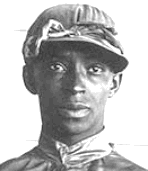
by TERESA GENARO
Only turf historians, or perhaps those who heard stories told by their grandfathers, would have recognized Winkfield’s name in the United States this decade. –Gerald Eskenazi in Winkfield’s 1972 New York Times obituary
 Three decades later, the New York Racing Association and the National Museum of Racing and Hall of Fame decided to do something about that.
Three decades later, the New York Racing Association and the National Museum of Racing and Hall of Fame decided to do something about that.
At the turn of the last century, Winkfield was an international celebrity. He won the Kentucky Derby in 1901 and 1902, one of only a handful of jockeys to win the race in consecutive years. Those accomplishments, though, meant little in the face of rising economic and racial pressures in this country, and the Kentucky native had to leave the United States for Europe in order to practice his trade. It was 1904, and he was 22 years old.
In the early 20th century, white jockeys in the United States were becoming increasingly resentful of the fame and fortune of black jockeys, who were among the highest-paid and best-known athletes of their time. Winkfield came to New York from Kentucky in 1900, and his first stop, according to Joe Drape’s Black Maestro, was the track at Sheepshead Bay, where the color of his skin was more important than his skill in the saddle.
“An Anti-Colored Union was in place, with the goal of running the black riders off the racetrack. It had begun earlier in the year at the Queens County track [Aqueduct] when the white jockeys…put the word out that if owners wanted to take home first-place purses, they’d best not ride the colored jockeys…Sometimes [the white jockeys] pocketed, or surrounded, a black jockey until they could ride him into and over the rail. Their whips found the thighs, hands, and face of the colored boy next to them more often than the horse they were riding. Every day a black rider ended up in the dirt; and every day, racing officials looked the other way.”
Winkfield’s attempt to crack the New York riding colony was short-lived, according to Drape:
“In two weeks, he managed three mounts, winning with one of them and finishing third on the others. No one missed him when he returned to Newport, Kentucky, and the Queen City track for the July Fourth weekend.”
Winkfield found Europe, particularly Russia, more hospitable. He lived there as one of the elite, riding horses and marrying into the Russian nobility, but fearing that he would be a target as the Bolshevik Revolution began, he left for France—saving the lives of dozens of horses by walking them with him. He was again successful there but again had to leave because of politics. Fleeing Nazi-occupied France for the United States, Winkfield worked here as a stablehand, as segregation and racism prevented him from maintaining the status he’d earned in Europe. He returned to live in France following World War II.
In 1961, Winkfield went back to Louisville to attend the Derby with his daughter Liliane…only to be denied entry to the Brown Hotel because of his race. He died in France at age 91 in 1974, and he was inducted in the Hall of Fame in 2004. A year later, the New York Racing Association named a race after him, which until recently was run on the Martin Luther King Jr. holiday.
In a December 2004 interview with NPR’s Tavis Smiley, John Lee, who was at that time director of broadcasting at NYRA, talked about the decision to name a race after Winkfield:
“There had been an idea floating around that we really should name the stakes races we run on Martin Luther King Jr. day for an African-American racing figure, and it had been a little bit on the back burner, and Jimmy Winkfield going into the Hall of Fame this year…helped push things along. And a key guy in moving it along was Coach Mike Jarvis, formerly of St. John’s [University]…he’s also a member of our New York Racing Association board of trustees…He…put it on the agenda for the next board of trustees meeting. He got a very receptive hearing from the chairman of the board, Barry K. Schwartz, and starting in 2004, we have the Jimmy Winkfield Stakes.
“We’re really looking forward to making the most out of looking back at history and maybe making up for a little lost time in honoring one of the all-time greats…”
According to Steve Crump, who made the documentary Forgotten at the Finish Line, about the roles of African-Americans in horse racing, thirteen of the fifteen jockeys in the first Kentucky Derby were black, as were fifteen of the first twenty-eight winners of the Derby. It appears that no other track in the country commemorates Winkfield in a race named for him; it seems odd that the state in which the man rode only three times is the only one that honors him with a stakes race—though, one might delicately suggest, its placement on the holiday celebrating Martin Luther King might be preferable to holding it on the holiday honoring men who enslaved the people whose descendants would go on to be so essential to horse racing’s success.



Teresa,
I hadn’t checked out your site for quite a while. Looking forward to the summer, I thought of Saratoga and your excellent coverage. I’m so glad I did, as I came across your superb essay on Jimmy Winkfield. Thanks for again giving coverage to the neglected topic of black jockeys.